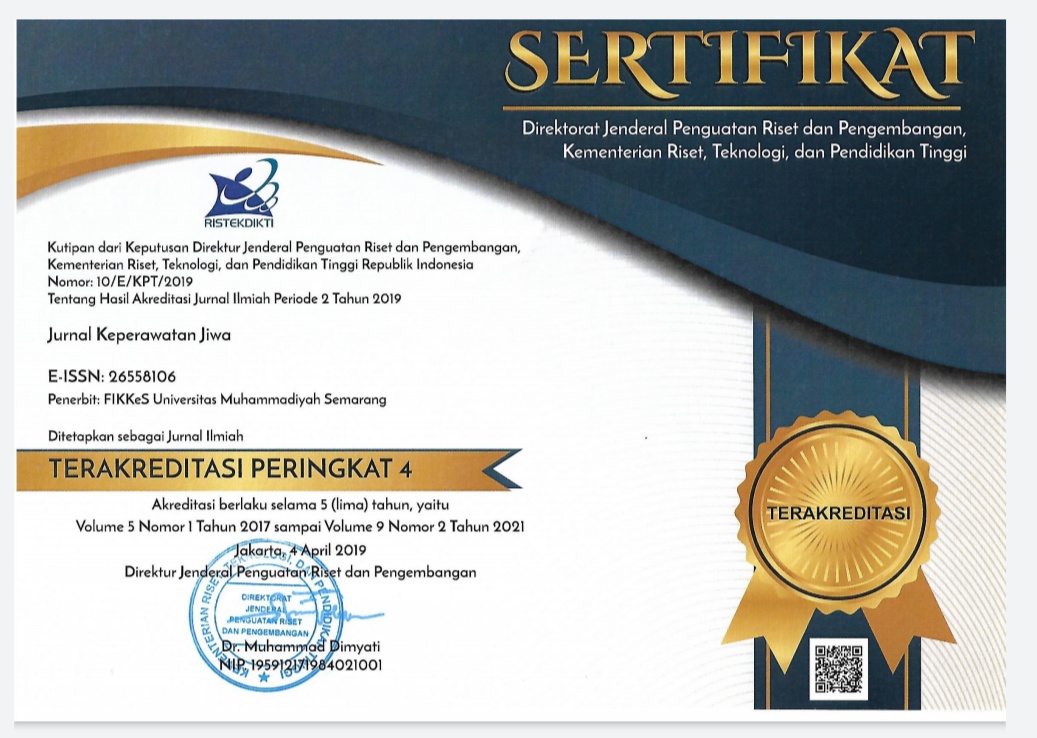Assessment of Spiritual Health and Well-Being of Psychiaric Nurses in a Mental Health Hospital
(1) STIKES Suaka Insan Banjarmasin
(*) Corresponding Author
Abstract
The practice of mental health care performed by nurses in mental hospitals requires nurses to also provide spiritual care. Nurses who have a healthy spiritual state can certainly provide good spiritual care to their patient. Unfortunately, nurses admit that in practice, this spiritual element is often overlooked and not considered important in practice. This study aims to examine the health and spiritual well-being of mental health nurses working in mental health care facilities (hospital based). This research was a pilot study using Mix Method (MM), the design of this study was a sequential research design (Qual-Quant) between quantitative and qualitative study. Data collection was carried out using a self-administered survey and using the SHALOM (Spiritual Health and life orientation measure) instrument from Fisher which had a total of 22 questions. Quantitative data analysis was performed using descriptive statistics, while qualitatively, the data were analyzed using the thematic analysis method. A total of 22 mental health nurses participated in this research project. This number represents the nurses who work in all wards in mental hospitals. Researchers used the cluster sampling method to select participants who were given questionnaires and the snowball sampling method to find suitable informants to be interviewed. This research shows nurses expressing worship of the Creator (Mean = 4.54, SD = 0.59) as the most important thing in the ideal standard of health and spiritual well-being. Likewise, with daily life and practice (Mean = 3.81, SD = 1.68). Nurses assess their health and spiritual well-being were more determined by the transcendental domain, especially with religious rituals. This study concluded that nurses have a well-distributed state of health and spiritual well-being ranging from the personal domain to transcendence, with dominance in the transcendence domain.
Keywords
Full Text:
PDFReferences
Aging, N. I. (1975). Spiritual well-being: A definition. . Athens GA, USA: NICA.
Arini, H. N., & Susilowati. (2015). Hubungan Spiritualitas Perawat Dan Kompetensi Asuhan Spiritual. Soedirman Journal of Nursing, 130-140. doi:10.20884/1.jks.2015.10.2.594
Attard, J., Ross, L., & Weeks, K. (2019). Developing a spiritual care comptency framework for pre-registration nurses and midwives. Nurse Education in Practice, 1-8. doi:https://doi.org/10.1016/j.nepr.2019.07.010
Barber, J., & Parkes, M. W. (2015). Handbok of spiritual care in mental illness . London : Birmingham and Solihull: Mental Health NHS Foundation Trust .
Eager, S. e. (2009 ). Spiitual care in the NHS. In C. Cook, Spirituality and Psychiatry . Royal Collge of Psychiatrist .
Fisher, J. (2011). The four domains Model: Connecting Spirituality, Health and Well-being. Religions, 17-28. doi:10.3390/rel2010017
Fisher, J. (2016). Asessing adolescent spieitual health and well-Being (Commentary related to social science and medicine-population health). SSM-Pupulation health, 1-3. doi:http://dx.doi.org/10.1016/j.ssmph.2016.04.002
Greasly, P., & Chiu, L. (2001). The concept of spiritual care in mental health nursing. Journal advanced Nursing, 33(5), 629-637. doi:10.1046/j.1365-2648.2001.01695.x
Hadi, I., Halid, S., & Istiana, D. (Februari 2017). ibm "Pelatihan Asuhan Spiritual Bagi Perawat di RSI Siti Hajar Mataram. Seminar Nasional Hasil Penelitian dan Pengabdian Masyarakat UNIMUS 2017 (pp. 561-565). Semarang: UNIMUS.
Ledger, P. B. (2013). Meeting spieitual needs in mental health care. Nursing Times, 109(9), 21-23.
Linda, N., Phetlhu, D., & Klopper, H. (2020). Nurse educators' understanding of spirituality and spiritual care in nursing: A South African Perspective. International Journal of Africa Nursing Sciences, 100187. doi:https://doi.org/10.1016/j.ijans.2019.100187
Ose, M. I. (2017). Pengalaman Perawat IGD Merawat Pasien Do Not Resuscitate pada Fase Perawatan Menjelang Ajal. Jurnal Keperawatan Indonesia, 32-39. doi:10.7454/jki.v20i1.378
Potter, P., Perry, A., Stockert, P., Hall, A., & Ostendorf, W. (2017). Fundamental of Nursing, Ninth Edition. Missouri: Elseviewe Inc.
Shah, R., Frey, R., Shipman, K., Gardiner, F., & Milne, H. (2018). A survey to explore health care staff perception of spirituality and spiritual care working in a single district health area in New Zealand. European Journal of Integratve Medicine, 1-30. doi:https://doi.org/10.1016/j.eujim.2018.07.006
South, B. (2007). Combining mandala and the Johari Window: An Exercise in self-awareness. Teaching and Learning in Nursing, 8-11. doi:10.1016/j.teln.2006.10.001
Taheri-Kharameh, Z., Asayesh, H., Sharififrd, F., & Alinoori, A. (2016). Attitude toward spirituality, Spiritual care and its relationshiop with mental health among Intensive Care Nurses. Health, Spirituality and Medical Ethics, 3(3), 25-29.
Timmins, F., Murphy, M., Neill, F. B., & Sheaf, G. (2015). An Exploration of the extent of inclusion of spirituality and spiritual care concept in core nursing textbooks. Nurse Education Today, 277-282. doi:http://dx.doi.org/10.1016/j.nedt.2014.05.008
Tyalor, E., Mamier, I., Ricci-Allegra, P., & Foith, J. (2017). Self-reported frequency of nurse-provided spiritual care. Applied Nursing Research, 30-35. doi:http://dx.doi.org/10.1016/j.apnr.2017.02.019
Vlasblom, J., Steen, J., Knol, D., & Jochemsen, H. (2011). Effect of spiritual care traning for nurses. Nurse Education Today, 790-796. doi:10.1016/j.nedt.2010.11.010
Yang, K.-P., & Mao, X.-Y. (2007). A study of Nurses' spiritual intelligence: A Cross-sectional questionnaire survey. International Journal of Nursing Studies, 44, 999-1010. doi:10.1016/j.ijnurstu.2006.03.004
Article Metrics
Abstract view : 575 timesPDF - 97 times
DOI: https://doi.org/10.26714/jkj.8.3.2020.279-298
Refbacks
- There are currently no refbacks.
PPNI Univ. Muhammadiyah Semarang
Jl. Kedungmundu Raya No. 18 Semarang Gedung NRC University of Muhammadiyah Semarang
Phone: 02476740287
Fax: 02476740287
Email: [email protected]
This work is licensed under a Creative Commons Attribution 4.0 International License.


